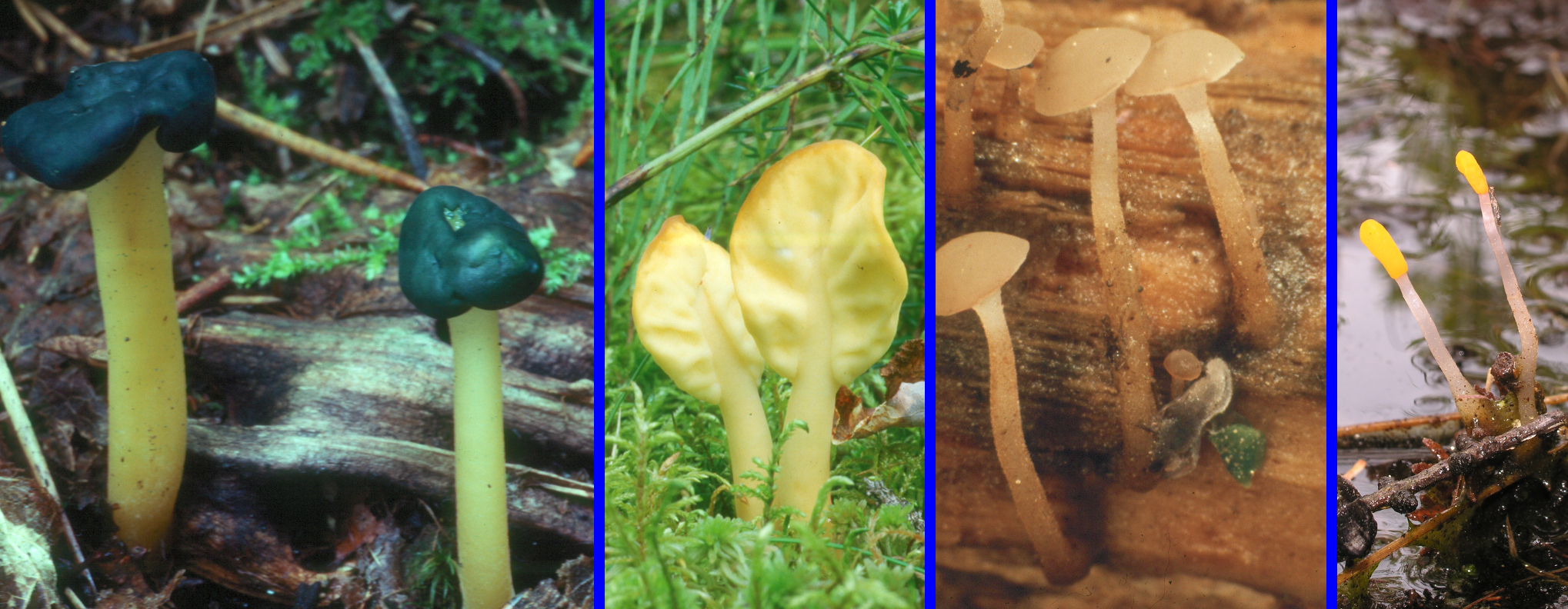Home >> Diversity and classification >> True fungi >> Dikarya >> Ascomycota >> Discomycetes >> InoperculateDiscomycetes >> Helotiales
HELOTIALES: THE NON-STROMATIC CUP FUNGI
Members of the Helotiales vary quite a bit and it can be rather difficult to define them. These are non-stromatic discomycetes that usually, but not always, have brightly coloured apothecia. The apothecia are usually, but not always, soft and fleshy and can be smooth or quite hairy or spiny. Perhaps it is easiest to define these orders by saying that they do not have the distinguishing features of the other orders of Leotiomycetes.
Although the genetic makeup of quite a few species has been studied we still do not have enough information available to construct a good "natural" classification. As an introduction to this group we present some of the variety of forms occurring in the Helotiales.
The pictures above illustrate some of the strongly stipitate members of the Helotiales. The two species at left are Leotia stipitata and Spathularia flavida. They are found in late summer or early autumn, usually on decaying leaves. The two at right are Cudoniella clavus and Mitrula elegans. Both of these species fruit on plant debris submerged in water, yet both disperse their ascospores into the air. Because of this the stipe is just long enough to elevate the apothecium above the level of the water. They are most commonly found in May and June in small seasonal streams. Just to prove that "big fleas have little fleas", click on the picture of Mitrula elegans to see an enlargement showing the larval case of a tiny mayfly that had crawled up on the fungus to emerge as an adult.
SURPRISE ALERT! Another common fungus you might think to be one of the stiptate Helotiales couldn't be more distantly related and still be an ascomycete. This fungus, Neolecta irregularis, is one of the most ancient of all ascomycetes. Read about it here.
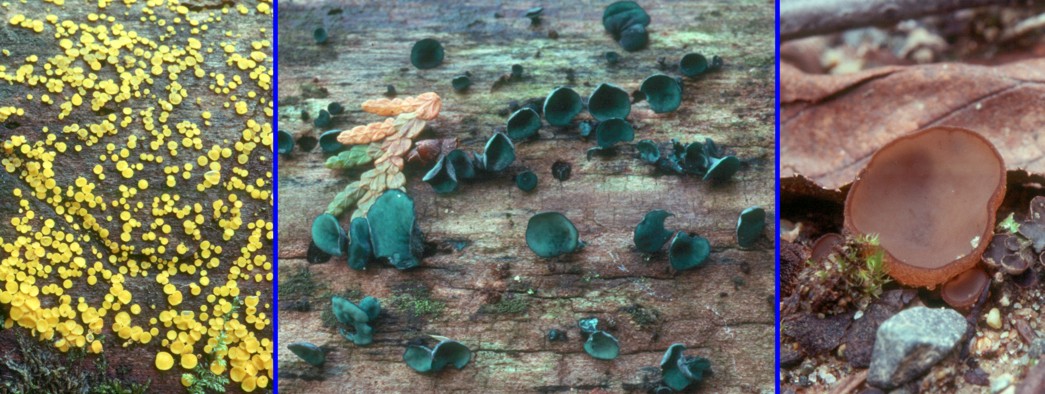
Many members of the Helotiales have obviously cup-shaped ascomata with little or no stipe, as ilustrated in the picture at left. At far left is Bisporella citrina, a common discomycete found on rotting logs and sticks. In the middle is Chlorociboria aeruginosa, also common in our region, usually found fruiting on logs and sticks of alder and birch. Chlorociboria aeruginascens is identifiable even when it is not fruiting since it produces a pigment that stains wood a bright blue-green colour. The wood has been used for decorative purposes, but is usually too decayed and fragile for any practical use. The apothecia have a short stipe that may be central or arise more or less to one side of the apothecium. The right panel illustrates Geocoryne variispora. It is misleading in the field because its colour and habit of growing on soil make it appear to be a sessile operculate discomycete, but microscopic examination shows it to be one of the Helotiales.
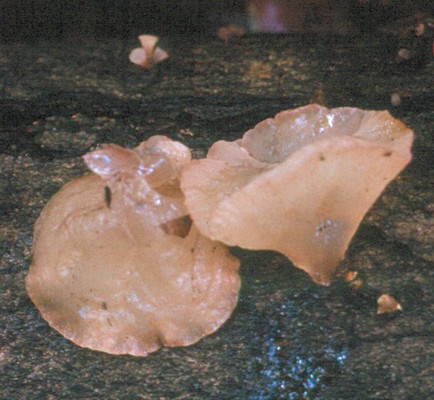
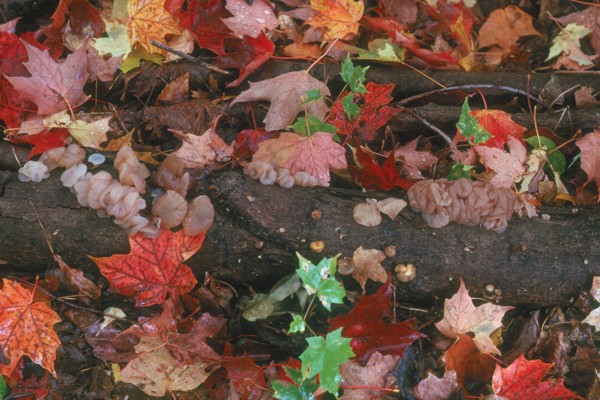
The two pictures at right demonstrate another feature found in some Helotiales, the production of gelatinous apothecia. In a manner similar to that in the operculate discomycete Sarcosoma globosa and most jelly fungi the hyphae of the apothecia develop gelatinous walls and are able to absorb a large amount of water. The fungus in the two pictures is Ascotremella faginea, a species found on rotting hardwood logs in the autumn.
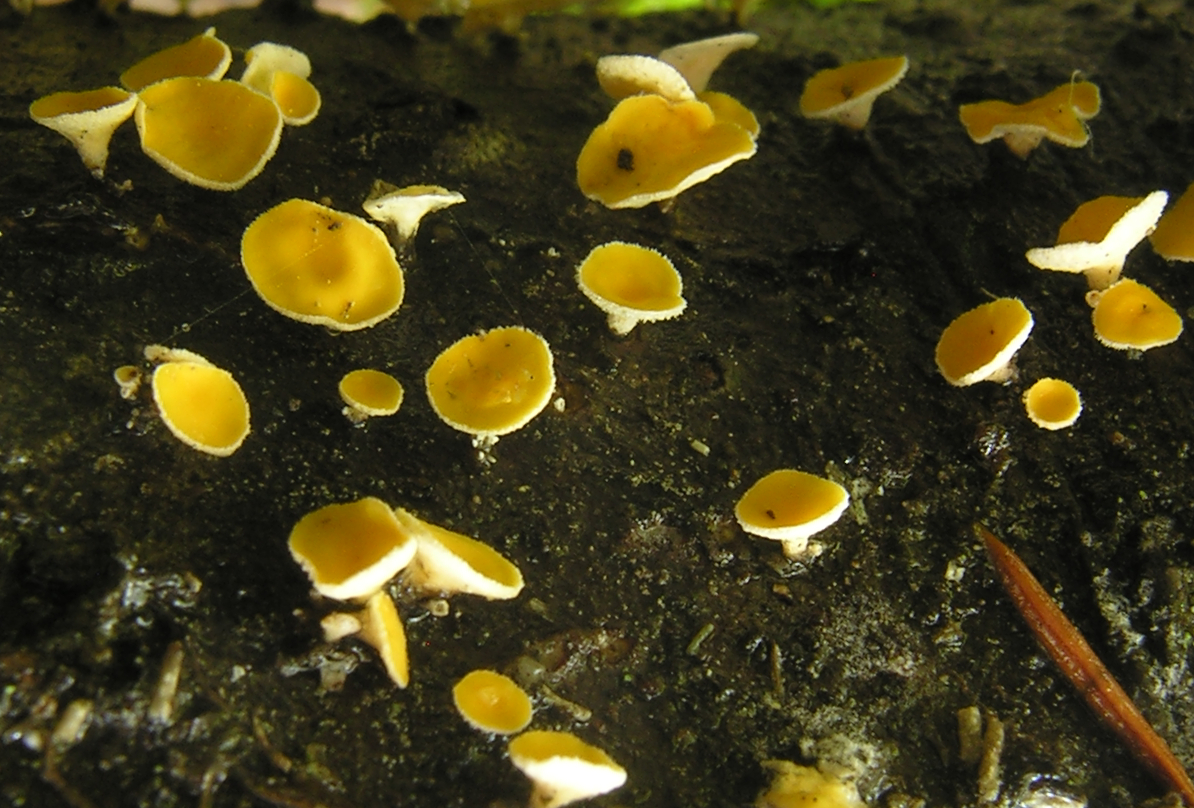
The fungus at left is Lachnellula agassizii, a member of the family Hyaloscyphaceae. This frequently-encountered family accommodates species having apothecia that are externally clothed with hairs or bristles. Lachnellula agassizii is very common in New Brunswick, colonizing the bark of balsam fir trunks that have died within the last year. It can be found on standing dead trees as well as logs, but they must be only recently dead. It is one of our most abundant fungi and can be found at any season of the year.
Lachnellula agassizii often shares its habitat with the basidiomycete Aleurodiscus amorphus and may sometimes closely resemble it. Read the essay on Real and Counterfeit Cup Fungi for more information about these interesting species.

Many inoperculate discosmycetes, such as those at left, have apothecia that are externally or entirely dark in colour. They can be confused with some non-lichenized members of the Lecanoromycetes but are easily distinguished with a microscope due to their typically inoperculate asci. Mollisia melaleuca, at far left, is a member of a large and difficult genus. Species of Mollisia occur on wood and dead plant stems in many different habitats. They have never been as thoroughly studied by mycologists as they should be and can be difficult to name. In addition, mycologists have been naming them for 150 years or more, so we have a lot of names available that we are not sure how to use. Mollisia species are often placed in the family Dermateaceae, characterized by apothecia with their excipulum (outer wall) comosed of more or less rounded cells.
The panels to the right of Mollisia melaleuca illustrate another interesting feature of many inoperculate discomycetes. These fungi thrive in very dry situations, usually the surface of wood and dead stems exposed to air above the ground. Their dark colours probably protect them against ultraviolet radiation from the sun and their tissues allow them to become extremely desiccated and then to revive when they are moistened. The species with apothecia nested on a red background is Patinellaria sanguinea. The red colour is a pigment that stains the surface of the wood. The two panels at right depict an unidentified apecies of Claussenomyces growing an dead wood of witherod (Viburnum cassinoides). The first of these two panels shows the apothecia in the dried state. When soaked in water for 30 minutes, as depicted in the right panel, the whole substrate seems to come alive. The apothecia of Claussenomyces have swollen up and reveal that the hymenium (the layer of asci in the centre of the disc) is convex and lighter in colour than the excipulum. You may also notice the yellow blobs by the apothecia. These are basidiomata (basidium-bearing structures) of a species of Dacrymyces, one of the jelly fungi.
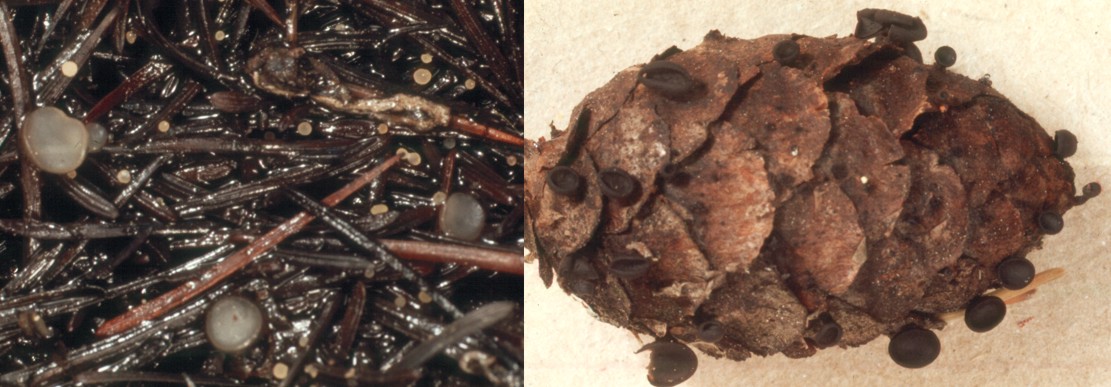
One of the features commonly noted in the inoperculate discomycetes is their specificity to one particular plant and often to a particular part of that plant. Host-specificity is often a characteristic of parasites, yet many of these discomycetes are found on dead tissues. Although we know very little about the life histories of these fungi it is reasonable to suspect that such species colonize the plant while it is still alive but not fruit until the part they are growing on is dead. At right are two such fungi; Moellerodiscus advenulus in the left panel and Rutstroemia bulgarioides in the right one. Moellerodiscus advenulus grows specifically on the fallen needles of larch while R. bulgarioides is found on spruce cones.
